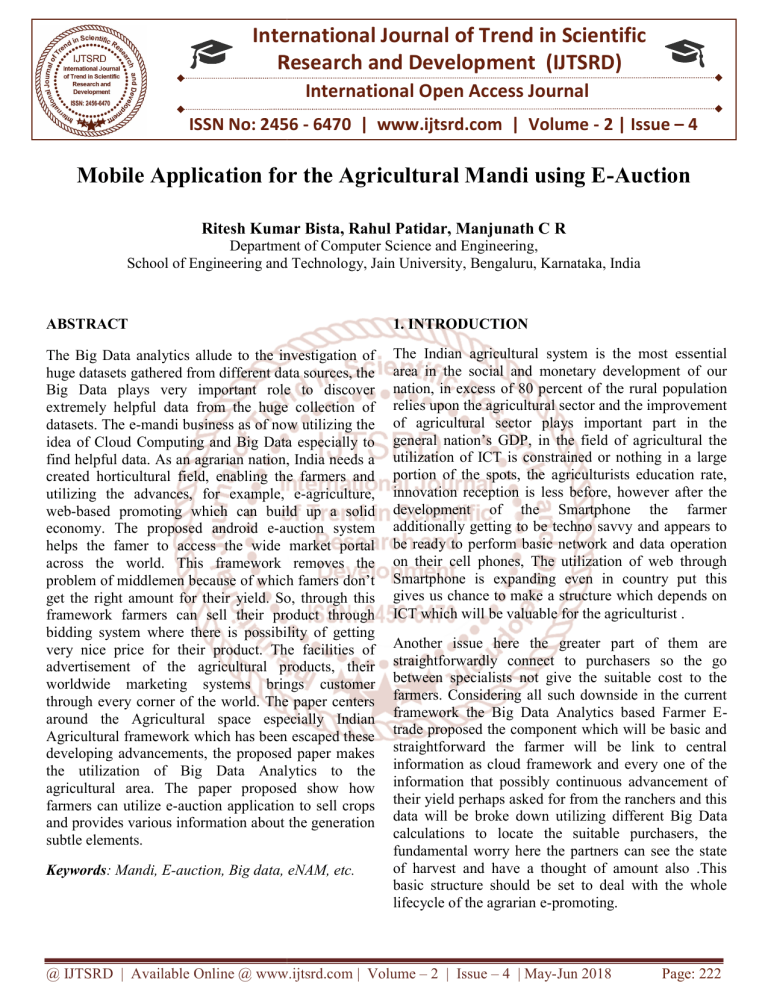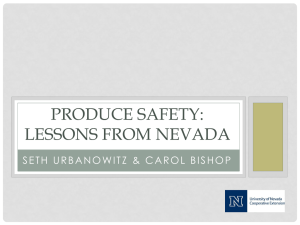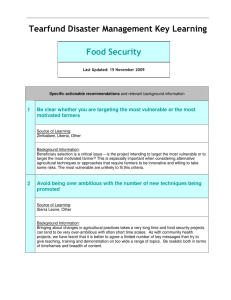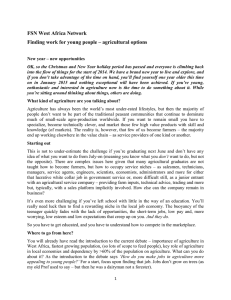
International Journal of Trend in Scientific Research and Development (IJTSRD) International Open Access Journal ISSN No: 2456 - 6470 | www.ijtsrd.com | Volume - 2 | Issue – 4 Mobile Application for the Agricultural Mandi using E-Auction E Ritesh Kumar Bista Bista, Rahul Patidar, Manjunath C R Department artment of Computer Science and Engineering, School of Engineering and Technology, Jain University University, Bengaluru, Karnataka, Karnataka India ABSTRACT 1. INTRODUCTION The Big Data analytics allude to the investigation of huge datasets gathered from different data sources, the Big Data plays very important role to discover extremely helpful data from the huge collection of datasets. The e-mandi business iness as of now utilizing the idea of Cloud Computing and Big Data especially to find helpful data. As an agrarian nation, India needs a created horticultural field, enabling the farmers and utilizing the advances, for example, ee-agriculture, web-based promoting moting which can build up a solid economy. The proposed android e-auction auction system helps the famer to access the wide market portal across the world. This framework removes the problem of middlemen because of which famers don’t get the right amount for their yield. So, through this framework farmers can sell their product through bidding system where there is possibility of getting very nice price for their product. The facilities of advertisement of the agricultural products, their worldwide marketing systemss brings customer through every corner of the world. The paper centers around the Agricultural space especially Indian Agricultural framework which has been escaped these developing advancements, the proposed paper makes the utilization of Big Data Analyti Analytics to the agricultural area. The paper proposed show how farmers can utilize e-auction auction application to sell crops and provides various information about the generation subtle elements. The Indian agricultural system is the most essential area in the social and monetary development of our nation, in excess of 80 percent of the rural population relies upon the agricultural sector and the improvement of agricultural sector plays important part in the general nation’s GDP, in the field of agricultural the utilization of ICT is constrained or nothing in a large portion of thee spots, the agriculturists education rate, innovation reception is less before, however after the development of the Smartphone the farmer additionally getting to be techno savvy and appears to be ready to perform basic network and data operation on their cell phones, The utilization of web through Smartphone is expanding even in country put this gives us chance to make a structure which depends on ICT which will be valuable for the agriculturist . Keywords: Mandi, E-auction, auction, Big data, eNAM, etc. Another issue here the greater part of them are straightforwardly rwardly connect to purchasers so the go between specialists not give the suitable cost to the farmers. Considering all such downside in the current framework the Big Data Analytics based Farmer EE trade proposed the component which will be basic and straightforward tforward the farmer will be link to central information as cloud framework and every one of the information that possibly continuous advancement of their yield perhaps asked for from the ranchers and this data will be broke down utilizing different Big Data Dat calculations to locate the suitable purchasers, the fundamental worry here the partners can see the state of harvest and have a thought of amount also .This basic structure should be set to deal with the whole lifecycle of the agrarian e-promoting. promoting. @ IJTSRD | Available Online @ www.ijtsrd.com | Volume – 2 | Issue – 4 | May-Jun Jun 2018 Page: 222 International Journal of Trend in Scientific Research and Development (IJTSRD) ISSN: 2456-6470 2456 Big data ata analysis in agriculture is the next wave in innovation to help all part of our lives. In agriculture, information administration has long been perceived just like a chance to drive farm productivity. It is just through the improvement new tools in data capture and information sharing that such opportunities can be figured out. New innovation improvement in agriculture has moved from sensors and machines to methods in big data analysis. Data analytics can be used to avoid wastage by moving items faster aand more efficiently. Which also helps analytics looking forward and back help with deciding the best crops to plant, thinking about both sustainability and benefit. 2. Problem Statement eNAM is the abbreviation of Electronic National Agriculture Market, which is a virtual market with a physical market (mandi) at the back end, which arranges the current nt APMC/mandis to make a bound together national market for farming wares for container India electronic exchanging. The measuring of horticultural create at the market level is of most extreme significance to upgrade the attractiveness of the deliver and to empower the farmers to acknowledge value similar to the nature of their agricultural produce. Mandis handles enormous volumes (parts) of landing and smaller parcels, consequently it is basic to give fast quality measuring arrangements (ideally inside a Volume: Volume refers to the amount of dataa collected. e.g., moment/parameter) to advance web based exchanging. high-resolution and high-frequency frequency of satellite and For this, the test is looking for development of fast aerial imagery. reviewing and examining solution for eNAM which can likewise be associated with the web to build the Velocity: Velocity refers to the speed of data processing. e.g., productivity of the agrarian chain. Improvement of ereal-time in-field field cameras for monitoring plant growth. commercial centers to associate food processors with agripreneur/agriculturists to connect the esteem hole. Variety: Variety refers to the large number of types ypes of data and While independence in agriculture has been a need for formats. e.g., traditional survey data vs. social media the Government and a few arrangement activities weave around this target, the post-reap post administration posts about food and food-borne borne illnesses. including farming advertising has not kept pace with Variability: the adjustments in economy, especially identifying Inconsistency of the data set can hamper processes to with setting up of a proficient inventory network. The handle and manage it. need to bind together market both at State and National Veracity: level is, hence, essential to give better cost to farmers, The data quality of captured data can var vary greatly, enhance store network, decrease wastages and make a affecting the accurate analysis. brought together national market for horticultural deliver. In such a situation, National Agriculture Market (NAM) would make a win-win win circumstance for both i.e. agripreneurss and processors. Generally, big data is characterized by the 5Vs: 3. Background Work Fig 1.1: 5V’s of Big Data The paper [1] proposed framework, National Agriculture Market which is a landmark initiative. This will help the farmer to sell their product on better option for sale and also could be able to access the wide market through gh warehouse based sale and also help farmers to transport their produce to the buyers. eNAM provides local trader to access the national market and for bulk transaction it provides access to the local mandi which decreases the intermediation cost. Hence by y this it is also helping the rural economy and is also providing more employment in rural area. @ IJTSRD | Available Online @ www.ijtsrd.com | Volume – 2 | Issue – 4 | May-Jun Jun 2018 Page: 223 International Journal of Trend in Scientific Research and Development (IJTSRD) ISSN: 2456-6470 The Authors of paper [4] proposed one android based the likelihood of better value discovery is quite application or framework, named as – Krishi Ville partial. which is basically for farmers. This mobile application Quality contrasts in products at both the state and handles all the updates of different agricultural national level represent a challenge. For instance, commodities, news regarding agriculture and updates, wheat in Punjab and Haryana is of mid-range updates of weather forecasting and various other quality through those from Madhya Pradesh and Gujarat are of higher quality. activities. Electronic stages like NAM would be a correct The Authors of paper [10] mainly focus on the stage just for exchange standardized products and challenges of e-agriculture and its various possibilities for the rest it may not be. in India’s rural context. It incorporates certainties on Middlemen have a large margin of profit, thereby Data asymmetry between farmers, districts and eating into the returns of farmers. Though nations. In the paper, it depicts E-agriculture with the consumers pay a fair price, farmers end up with utilization of current Information and Communication paltry returns. Technologies (ICT). Mandi is a closed system. Everyone is not provided with the opportunity to sell in the mandi. As per the The paper [16] describes about the demand and supply respective state APMC Acts, the admission of of agricultural products using technologies like clouds middlemen (aka sellers) are regulated. Mostly by and grids. They discussed on various necessities and prior registration cum licensing and few times by difficulties in designing such market called mandi. lottery, the sellers are allowed in Mandi. As Their system architecture also helps to measure the everyone knows in this country, entry to Mandis as mandi performance and estimating the overhead time a seller involves a lot of bribery and lobbying. All of interaction between buyers and sellers. these costs end up in eating consumers’ pockets. Mandi system doesn't provide credit lines to 3.1 Existing system farmers during cultivation (like those Big MNC It essentially focused on coordinating 21 mandis in giants) and leave farmers in their tough period. eight states; Uttar Pradesh, Gujarat, Telangana, The existing system has a lot of deficiencies due to Rajasthan, Madhya Pradesh, Haryana, Jharkhand and which small farmers are not getting sufficient Himachal Pradesh. Propelled with a spending income for their livelihood. distribution of Rs. 200 crores, 25 key agro produces, including wheat, paddy, maize, onion, jowar, bajra, 4. Proposed System groundnut, potato, soyabean and mustard seed, were To overcome the issues in the current framework, we decided for e-trading. According to Press Information proposed a framework that removes the broker Bureau, Government of India, Ministry of Agriculture, between farmer and market and farmers can apply new 07-April-2017, up until now, 417 markets from 13 methods from the specialists through this framework. states have been incorporated with e-National This framework gives stage to the agriculturists where Agriculture Market (e-NAM) against the set focus of they can know the costs of various markets and can 400 markets by March. What's more, according to the offer their harvest for best cost. Our fundamental target affirmed e/ - NAM Scheme, 585 controlled mandis the is to make a system that incorporates the majority of nation over are to be incorporated into the gateway by our horticultural subjects and questions in a similar March 2018. system where all the agricultural purposes can be possible effectively. In light of the need, the request 3.2 Limitations of Existing system determining for a specific harvest is done subsequently helping the agriculturist return better benefit. Even if the structure looks basic, for agriculturists, it may not be as straightforward of course. A large portion of the agriculturists has a convention of distributing their deliver to a nearby item aggregator at that point taking their crops to the mandis. Even if a few farmers take them to mandis, their yield would be irrelevant to motivate far off purchasers offering on the web. In this situation, @ IJTSRD | Available Online @ www.ijtsrd.com | Volume – 2 | Issue – 4 | May-Jun 2018 Page: 224 International Journal of Trend in Scientific Research and Development (IJTSRD) ISSN: 2456-6470 2456 Fig 4: Workflow diagram ram Fig 4.1: Trading Scenario Agricultural e-mandi mandi is an electronic trading portal 4.2 Module Design launched for the farmer’s welfare to facilitate farmers, The idea is to develop an online bidding b traders, buyers, exporters and processors with the application that would help the farmers and the common platform for trading commodities. The customers contact each other directly and do framework is managed by the farmers and other the business. experts. Traders and exporters need to register with the The online forum will help the customers framework to access the services provided by the interact with each other. trading portal. Farmers get to know the actual demand in the market through the requests that th customers post 4.1 Trading Scenario on the application. The Figure demonstrates a run of the typical situation This application will be made available to of exchanging directed inside Mandi. In the example anyone across the country via accessing the given, Mandi led a double e-auction auction to coordinate URL. offers of various asset solicitations to the suppliers inquire. To start with, the suppliers promote their assets with their cost (otherwise known as inquires). Purchasers present their offers to demonstrate their enthusiasm thusiasm for renting the publicized assets. Every one of the offers and asks are put away in the database which will be gotten to toward the finish of the auction for ascertaining the triumphant offers. The Meta MetaBroker, which is the primary specialist of M Mandi, facilitates the coordinating of asks and offers, and exchanging between auction members. Toward the finish of the auction, the Meta-Broker Broker chooses the winner and sends the reservation solicitations to the Fig 4.2: Module design Reservation Service of Mandi. Then the Reserv Reservation Service illuminates the asset suppliers and consumers 4.3 Android Application Framework about the auction result. The data about reservations is An Online Bidding application deployed on put away inside Mandi utilizing the Accounting Cloud Platform as a Service (PaaS) ( for sales of administration. agricultural products and deploys end to end live application feature. feature The proposed system will be a mobile application using which the bidders (Buyers) and the sellers (Farmers) contact each other. They don’t need to go anywhere. This application pplication is available publicly to all the @ IJTSRD | Available Online @ www.ijtsrd.com | Volume – 2 | Issue – 4 | May-Jun Jun 2018 Page: 225 International Journal of Trend in Scientific Research and Development (IJTSRD) ISSN: 2456-6470 2456 sellers, farmers and buyers across the country. Anyone can access this application and search bid on the products based on their requirements. 4.3.1 Login and Signup Module Login and Signup module is used to register aas buyer/seller. If you are already registered then enter the required details and sign in and start online trading but if you are a new user then you need to fill all the required details for trading purpose with the help of signup. In case if you forgot your our user id or password then you can retrieve new password using your registered e-mail id. Fig 4.3.2: Profile page 4.3.3 Auction Module Auction uction details module is used by farmers/buyers based on their requirements. It has category option where you can choose category of your interest. Then enter the name of crop you want to sell and then mention quantity in kg. Administrator has all the authority ority of fixing the base price based on the quality of the product. The buyer having the highest bid during the bidding duration will be declared as the winner and the product will be sold to that individual. Fig 4.3.1: Login page 4.3.2 Profile Module Profile module is used to view and update the buyers/seller’s details. Using this module the user can check their orderss through My Orders. They can also view their auction stats and also can create auction or can check active auctions present. And at at-last there’s sign out option for user to log out from the current session Fig 4.3.3: Auction page @ IJTSRD | Available Online @ www.ijtsrd.com | Volume – 2 | Issue – 4 | May-Jun Jun 2018 Page: 226 International Journal of Trend in Scientific Research and Development (IJTSRD) ISSN: 2456-6470 4.4 Features of the Proposed System Delivering the product might take some time depending upon the address of the buyer and seller. With the help of big data performance tools, analyze the information in light of the need of area and kind of yield recommendation can be conveyed to farmers 5. Conclusion through this framework. The framework can contain As agricultural nation, we require a strong innovation features as specified: and information base framework to keep pace with Firstly, the promoting framework of present day agribusiness of the world which will make agricultural items helps the farmer to offer their our nation a really developed one. This online interface horticultural product with its related image will help a considerable measure to develop our nation from any place across the nation. in an appropriate manner by removing poverty and System can give farmers the approximate creating the sources of self-employment for the large capacity of the cultivated items in any season number of population of our nation with the assistance along with the cultivation field’s measure. of present day science and innovation. It would help in This framework can help farmers to know expanding efficiency and in accomplishing objective about different crop diseases and can get the of food security and comprehensive development in remedy of the same from the experts. the nation. Moreover, these changes in agricultural The distinctive techniques for cultivation of market will help India to address the difficulties various crops with new innovation to keep pace postured by worldwide markets in the time of with the cutting-edge world. globalization and advancement. The utilization of the different horticultural apparatuses, that is name, cost, offer place with 6. References the photo can arrive which will expand the 1) J.P. Yadav, Abhishek Sharma, “National nature of the instruments to the farmers so the Agriculture Market: The Game Changer for Indian agriculturists can develop more harvests. Farming Community”, University of Rajasthan, At-last, the user of the application can also be Jaipur, IJSRM Volume 5 Issue 07 July 2017 allowed to access the daily news regarding the 2) Lucking-Reiley, David (2015), “Auctions on the agriculture. Internet: What’s Being Auctioned, and How?” 4.5 Limitations of Proposed System Journal of Industrial Economics, 48(3): 227–52 The above proposed system has some of the challenges 3) Satish G. Athawale, Asst Prof., MGMs Institute of listed below which can be addressed. Management Aurangabad, Maharashtra (India), “APMC and E-trading for Financial Inclusiveness The seller might not get best price for the in Karnataka” product if there won’t be many buyers to bid on because of which the product might go on less 4) Manav Singhal, Kshitij Verma, Anupam Shukla, “Krishi Ville-Android based Solution for Indian price. Agriculture”, Advanced Networks and Buyers might not be aware of the auction Communication Systems(ANTS)2011, Bangalore timing. As seller can create auction at any ,26th 2nd November 2015, pp. 134-139. period of time. Both buyers and sellers should be mobile 5) Jie Wang, Shuo Yang, Yuezhi Wang and Cheng friendly. If the user don’t know how to use Han, “The Crawling and Analysis of Agricultural mobile it will be difficult to the user to use the Products Big Data based on Jsoup”, 12th application. International Conference on Fuzzy Systems and As it is online process, the users must be Knowledge Discovery (FSKD), 978-1-4673-7682connected to the internet to access the auction 2/15. and to buy/sell the product. Required product might not be available on 6) Anu Peisker and Soumya Dalai, “Data Analytics for Rural Development Indian Journal of Science time as it depends upon the seller to which and Technology”, Vol 8(S4), 50-60, February 2015 product he/she wants to sell. 7) Ch. Chandra Sekhar, Ch Sekhar, “Productivity improvement in agriculture sector using big data @ IJTSRD | Available Online @ www.ijtsrd.com | Volume – 2 | Issue – 4 | May-Jun 2018 Page: 227 International Journal of Trend in Scientific Research and Development (IJTSRD) ISSN: 2456-6470 tools”,2017 International Conference On Big Data 12) Aditya Saxena, Surendra Pratap Singh, Manju Analytics and computational Intelligence Rani, Manoj Kumar, “A Study of Crop Yield (ICBDACI) pattern with Climate Change based on Physical Parameters: Temperature and Rainfall in Western 8) Wang Xiaoyu, Zheng Wensheng, Zheng Yaqin, Uttar Pradesh to make future predictions for better “Under the Perspective of fresh agricultural Crop Management and Yield”. products E-commerce supply chain model research,” Journal of chongqing institute of 13) Mukesh kumar, Prof.Mayura nagar, “Big Data technology (social science edition), vol.12, pp.60analytics in agriculture and distribution channel”, 63, 2016. Proceedings of the IEEE 2017 International Conference on Computing Methodologies and 9) Er. Rupinder Kaur, Raghu Garg, Dr. Himanshu Communication (ICCMC), 978-1-5090-4890-8/17. Aggarwal, “Big Data Analytics Framework to Identify Crop Disease and Recommendation a 14) Ms. Nirali A. Kansagara, Ms.Trupti M. Khurape, Solution”, 2016 Ms. Jyoti S. Kamble, Ms. Manasi M. Kulkarni, Prof. Mr. G.I. Rathod, “An Android Application for 10) Deka Ganesh Chandra, Dutta Borah Malaya , “Role Online Agri-Auction” e-ISSN: 2395 -0056 Febof E-Agriculture in Rural Development in Indian 2016. Context”, Emerging Trends in Networks and Computer Communication,20 11, Udaipur ,22nd 15) Guo, “A Study of the Application of Big Data in a 24th April 201 I, pp. 320-323, 201 I. Rural Comprehensive Information Service. Data Science Journal”, 14: 12, pp. 1-8, 2015 11) Purnima Shah, Deepak Hiremath and Sanjay Chaudhary, “Big Data Analytics Architecture for 16) Saurabh Kumar Garg·Christian Vecchiola· Agro Advisory System”, 2016 IEEE 23rd Rajkumar Buyya, “A market exchange for trading International Conference on High Performance utility and cloud computing services” Computing Workshops @ IJTSRD | Available Online @ www.ijtsrd.com | Volume – 2 | Issue – 4 | May-Jun 2018 Page: 228




